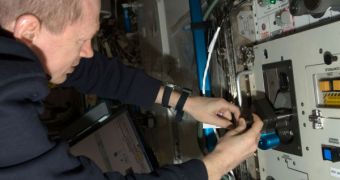After having successfully docked to the International Space Station (ISS), in spite of being an experimental design, the unmanned Japanese H-II Transfer Vehicle (HTV), a cargo freighter, is getting ready to undock from the station and meet its fiery demise upon atmospheric reentry. Members of Expedition 21 spent yesterday performing unloading operations, and clearing the HTV of all the supplies it contained. The Japanese Space Agency (JAXA) was unsure whether the craft would reach its destination, so all the supplies that did make it, a couple of tons, were in excess.
When experts plan how to divide the task of refueling the space station, they do not take into account experimental, new designs that might fail. This would entail the risk of astronauts being left to fend for themselves in orbit, which is impossible. Therefore, the new supplies that did make it to the orbital lab aboard the HTV are extra, in addition to the things stated in the official supply manifest. Throughout Tuesday, the six-astronaut crew aboard the facility transfered the stuff to the outpost, and started depositing residues inside the capsule.
The Japanese vehicle is scheduled to be deorbited on Friday, once all the residues from the ISS are safely secured in place. It will burn up during reentry, over the Pacific Ocean, and no substantial pieces of it will remain, astronauts estimate. While flight engineers Roman Romanenko (RosCosmos), Jeff Williams (NASA) and Nicole Stott (NASA) were busy with loading the module, flight engineer Robert Thirsk worked with the Binary Colloidal Alloy Test (BCAT-5) experiment, which looks at the behavior of colloids in low-gravity. Results from this experiment could lead to more efficient production processes for a wide array of everyday objects such as paint, plastics, food, and cosmetics.
During this time, the newly appointed Commander of the ISS, Frank de Winne, an astronaut of the European Space Agency (ESA), spent his time conducting amateur radio experiments, and communicating with students from the Warsaw, Poland-based Copernicus Science Center. According to Space Fellowship, the Urine Processing Assembly (UPA) also experienced a glitch, and the astronauts suspect that the mishap might have occurred between the Distillation Assembly and the Fluid Control Pump Assembly. The ISS crew is scheduled to look at the UPA on Friday.

 14 DAY TRIAL //
14 DAY TRIAL //